
So, having been a huge fan (understatement if there ever was one) of Batman: Arkham Asylum, I was waiting with baited breath for Batman: Arkham City, delivered by Rocksteady Studios. I don’t normally pre-order games at the store or even online via D2D distribution methods, but for this one I was willing to make an exception. Arkham Asylum was, without a doubt, one of the most satisfying purchases on the XBox I have made to date and needed a good kicking to pull if off its podium. Since we are talking Batman here, I think we can all agree that the only thing capable of pulling Batman off a high and hard-to-reach vantage point is another Batman.
I will also warn the comic book fans out there that this review is not being written with the DC Comics in mind. While I do like comics and such I am not a collector in any sense of the word and have other hobbies that make no time for keeping up to date on the latest in the DC or Marvel universes. I do understand, though, that the current ranges of Batman games are the result of a reboot of the DC comic universe where they go back to the beginnings and retell the stories many people in my age group (30’s onwards) grew up reading. Hence why those of us with a pedestrian knowledge of Batman and the setting will look at the new games and wonder where all the awesome redesign work fits in. And it is awesome, without a doubt. Even though such a comment is purely based on aesthetics.
Going back to the beginning of this blog you might see I have never reviewed Batman: Arkham Asylum. It is one of those games I have not gone back to since completing to the fullest extent. But I will say it is one of those games where I have endeavored to compete to the fullest and doing as much of the side missions as possible. It does not have the same re-playability as some games, though, and once done you have pretty much done entirely. The bad guys are gone, the last easter eggs have been found, the collectible bonus content has been unlocked as much as you care for and all you are doing is running around a set piece. I draw your attention to this point about the easter eggs and side missions as I will come back to these concepts later and at least I can highlight, in retrospect, the slight differences in game philosophy at work between Arkahm Asylum and Arkham City.
Since my Gears of War 3 review, I have been trying to work on a better template to lay out a review. I will start by touching on the storyline and what the game is about, then get to work on the heat of the gameplay, the good and bad included, and then dissect the story and presentation/immersion of the game towards the end.
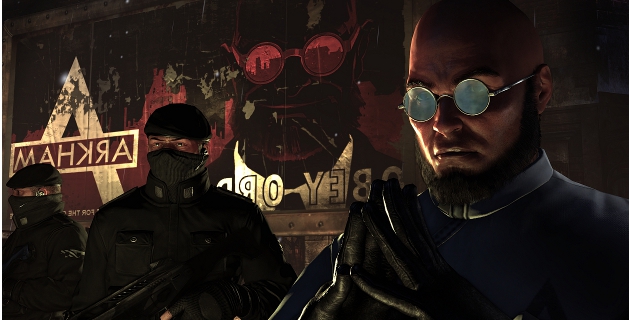
So, starting with the story introduction, Arkham City is a follow on from the previous game in terms of the story. All the supervillains of Gotham City are corralled into a new super penitentiary under the order of the new Gotham City mayor, Quincy Sharp. Sharp, as players of the first game will know, was the old warden of Arkham Asylum, now destroyed after the Joker’s previous breakout and riot. And anyone that did as much of the side missions as possible will know Quincy Sharp has a dirty secret of his own, which in Arkham Asylum was simply a nice side story yet now plays a major part in Arkham City’s story. I will not spoil it for people right now as you can find out by playing if you wish, and anyone wanting to play the first game before taking on Arkham City. I will say that if you care to know all there is to know, work hard in the first game to find all the secrets of Arkham Asylum. It is worth doing all the way to the final bonus secret.
Anyway, Sharp has given control of the new super-penitentiary to Professor Hugo Strange, formerly of Arkham Asylum, and father of the Arkham City concept. A private security force, TYGER, purchases the ruins of the old Arkham Asylum island across the bay, and is also contracted to provide exclusive security to the new super-penitentiary as well as being used to bolster Gotham’s own police force for a time while dangerous criminals were being rounded up. Finally all known criminals have been brought to Arkham City, which is a walled off section of Gotham’s old docklands, and all seems well. However, something does not sit right with Bruce Wayne, aka Batman, when he is attacked by TYGER security one night on watch over the city. (See the trailer below, which is a prelude to the game). Hugo Strange’s name pops up so he as well as Commissioner Gordon try to get Arkham City shut down. Batman also steps in as Bruce Wayne to voice his support to such a campaign but many petitions are blocked. Eventually, at a press conference outside the gates of Arkham City, Bruce Wayne is arrested by TYGER security in a rather heavy-handed looking operation and wakes up in a room with Hugo Strange, who knows he is Batman, and being told he is now a resident of the prison.
And thus begins the game, in what I like to think is the best intro sequence to a game I have yet to play. The level of involvement in being processed by TYGER is something rare in games still. You have to initiate action by rocking the chair back and forth trying to escape. You have to counter the kick from a guard and break his knee, you are then dragged to the gates and thrown into the prison city where you are set on by other prisoners looking to give new arrivals a warm welcome. Fight these guys off with your cuffs on before being ultimately beaten down by some of the Penguin’s boys who want to thank Bruce Wayne for all the bad blood between their families in the past. Of course, he does not know he is dealing with Batman in his Sunday clothes and gets a royal whooping.
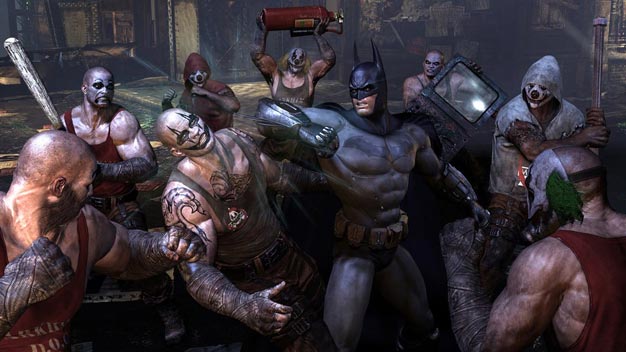
So, how does combat feel? Well the game is true to form from the first game, using the same engine allowing for an advanced free-flow combat system. Punches and kicks take place very fluidly and are based on many circumstances of how Batman and his target are situated. If the target is behind you, for instance, and kicking, Batman might grab the leg and deliver an elbow to the gut if he is squatting from his last attack.Or he could block it with his hand and spin, giving the guy a punch if he is standing. Counter attacks are crucial, especially in the higher difficulty settings, since they interrupt a hostile attack and deliver a blow of their own. In some fights you can take on about 20 guys at once using a mix of attack and counter attack to avoid being hit. You can vault over enemies, distract them with a flash of the cape, or use one of many ‘quick fire’ gadget attacks such at batarangs, batclaws and electric charge launchers.
There is a levelling system in the game which lets you upgrade Batman with more capabilities and sometimes new gadgets or an improvement to existing ones, as well as some new attacks and counter attacks. SOme of these are special combo attacks you can use once you reach an uninterrupted hit combo of 12 hits, and eventually 5 when you upgrade on a level up. These often give you the ability to knock out one or several henchmen putting them out of the fight. And the more of them there are in a group, the longer you have to beat each one down to knock them out permanently.
I have always found it hard to play any melee based game since Arkham Asylum, as many of them fail to live up to the way the Batman games handle unarmed combat. I touched on this with my review of Space Marine a while back, wishing it had the same level of precision with strikes on an enemy. But Batman is not all about running into a room headfirst and kicking arse. Batman hangs from the rafters and takes down the enemy one at a time in the shadows as well, and many games have failed to mix a workable stealth system with combat. Metal Gear Solid on the old PS1, for instance, opened the genera of stealth games with a good initial venture into the mechanic as a central gameplay feature. It was done well, also, though when the game fell into a combat situation, the controls were all taken up by stealth moves and aiming a gun was tedious and nothing like pure combat games. And likewise games that attempt to bring in stealth as an option in combat have little options available though they do combat very well. Batman has none of these problems, with stealth being achievable not only in equal measure but also as a means of continuing combat.
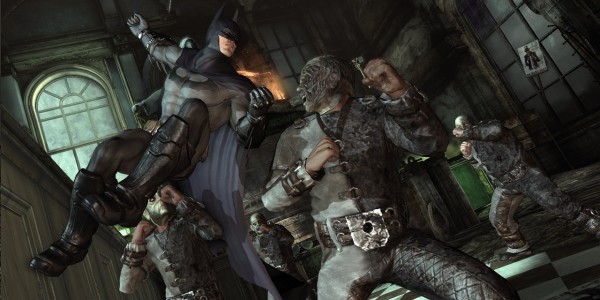
There is a certain satisfaction in dropping from the shadows behind an armed thug, doing a silent takedown from behind, then grapple-hooking to the next overhanging gargoyle before being seen, leaving everyone to panic when they see their friend out cold. They begin searching for you, and you pick another one-off, and another, and with each one that joins the land of nod, the survivors get more and more terrified. And if you slip up and end up being seen, and have to bail out because they all have guns, you can use the stealth to hide and wait for them to calm down a little before trying again.
Sometimes, well nearly all the time actually, combat is made a little easier with the use of the ‘detective vision’ gadget where Batman can see the city in a different light. A blue one to be precise. Detective vision is mostly used by Batman to assess the area for threats that are not always apparent. You can see enemies through the walls up to a good distance away, and when you hear some of them speaking (and Batman can hear quite far away with his microphone sensors in his ears) the detective vision picks up which person is speaking. This never becomes an important factor in the life of Batman while playing the game but it is a nice touch never the less. More importantly, though, Batman will see which enemies are armed with a gun, knife, bat, pipe, bottle or riot shields. Gun enemies show up orange, others show blue with handheld weapons themselves being yellow. Looking around and centering your view on an enemy will give a status readout on them showing if they have a weapon or not and what it is, and if they have armour on then you see them clad in yellow plates and a marker shows this too. Also you can see their heart rate and a nervousness indicator based on this. Again, not needed in any form of gameplay but it is nice to see how much terror you are inflicting on someone.
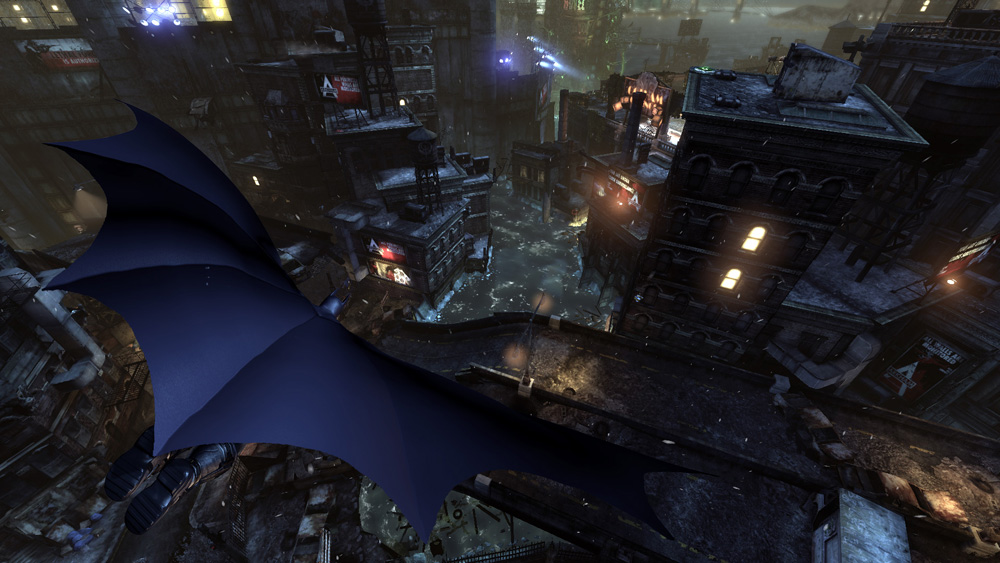
it is essential, unless ice water dousing is your thing.
Getting around Arkham City is interesting as well, even more than the old Asylum game where most of it took place inside one building or another, instead of the outdoors. With the more open city feel of the new setting, they have made better use of gliding with the cape and the use of the grapple to get around. Now, rather than gliding and slowly falling, you can do a nose dive before pulling up again and glide further. While you need to start from a high place to begin with you can glide pretty far with practice. And if you find yourself lacking room there is always an upgrade to unlock for the grapple to boost yourself forward if you wish. Simply grapple to something above you and double-tap the appropriate button to put the reel into overdrive, then hold down the glide button again. When you reach the ledge or whatever you were grappling to you will be launched into the air instead of landing on it, and continue to glide a little further. This is also used for an entertaining combat attack where you can glomp anyone near the ledge with a different button combo, taking them out of the fight instantly.
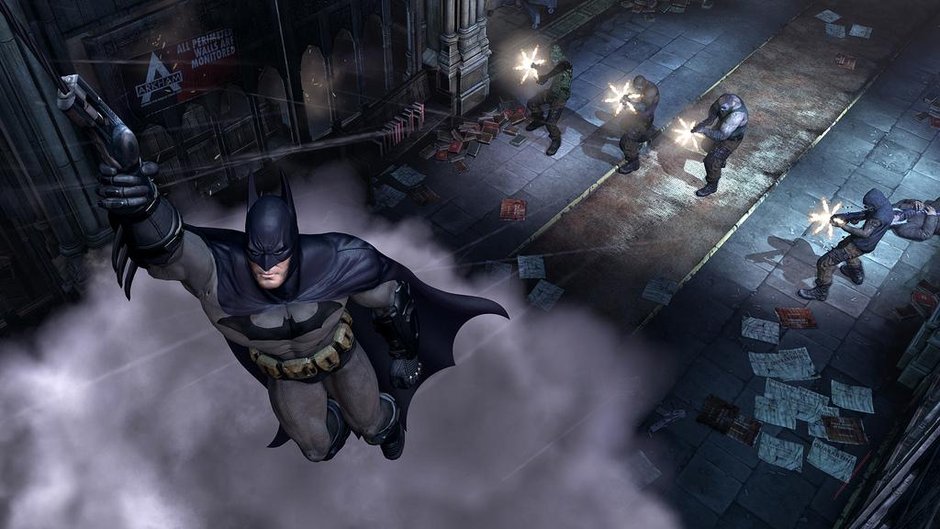
they will follow you and keep shooting until you are out of sight.
Just to further expand on the grapple, and control mechanics in general, for the uninitiated, control mechanics are meant to be more intuitive when it comes to environment interaction with a lot of auto-aim instead of manual being the essence of the system. When you throw a batterang, if there is an enemy in range then it will auto-aim at them. When you look around, a marker is projected onto ledges and gargoyles automatically showing what you will grapple onto if you use it. Meaning you can ‘quick-fire’ your gadgets without needing to aim them first. If combat is getting tricky, you can always bail out (if there is a ledge in range anyway) by hitting the bumper button that uses the grapple. Batman will automatically grapple to the ledge the game thinks you wish to use, even when you are not looking up is it always has one selected if there is one in range, and you will be hoisted out of the area. Or at lease, you hope so, since if you are not looking you might just grapple to the low hanging lamp post just behind you. This is fine if you are in a pure fist fight but when you have armed guys shooting you this would still be bad. Even then you have the option of dropping a smoke pellet, with another quick-fire button available when under fire, to confuse the shooters and escape easier.
This helps to keep the flow of the combat even though it does sound like the game is always in easy mode. This is not the case, though, since it is overall well balanced and still manages to be challenging despite having a counter for every circumstance you can find yourself in. Sometimes being reckless will get you up to your eyeballs in enemies and you can be taken down quickly.

bad bunch in the game.
Enemies can be varied as well, though there are less freaks to worry about compared to the first game and most are simply run of the mill henchmen with different assortments of weapons. The first variations you will encounter are simply unarmed or have bats and pipes. Then you will have enemies with guns showing up, meaning you have to be more careful until you level to upgrade more effective counters to an armed enemy. Some enemies will have body armour, making them generally impervious to standard punches and kicks and requiring a special beat down attack. Some have riot shields or homemade ones from car doors, requiring another kind of attack to disarm them. Some have knives or broken bottles, which you have to use the counter button to dodge instead of attack. Some eventually have shock sticks making frontal assault impossible without being zapped. Also there are enemies that use a jammer on a backpack to scramble your detective vision until he is taken down. Anyway you get the idea. My telling you this here is not really a spoiler either as the game has a habit of giving you a little tutorial each time a new weapon comes into play and shows you how to counter it anyway.
Finally, we come onto the visual department. The Unreal engine has been upgraded again and the latest one is on show here in Arkham City. Textures look very nice, and very detailed, and lighting and water effects are well done. In short they are applied very well to the game. That is all to say really. I have not seen any glitches in my playthrough and some of the twisted reality effects benefit from this competent rendering. (more on this in a moment) Of course the art team have also done an amazing job in realising the new vision of Batman and the cast of this series keeping a consistent theme and feel for the locations mixing classic looking Gotham City architecture with modern influences.
The game is an open-world sandbox feel though with a linear storyline at the centre. Go to point A, beat up bad guy B after fighting off his minions, he tells you about location C and go there to find object D and so on. It does diverge a little giving you multiple objectives, but they all need to be met to progress past that mission hub point. So really, the only open-world element of the game is that you can go anywhere from the start, with the exception of mission-specific places. You can take any kind of route you wish to the next location without always having to go through one place that links to another like Arkham Asylum.
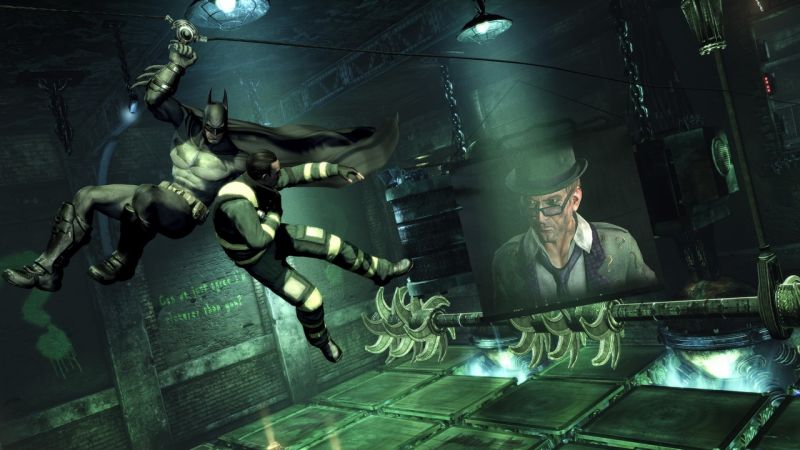
and save one of his hostages.
There are also little side quests to conduct, giving you a deeper storyline experience in most cases. There are the usual Easter egg hunts that have come from Arkahm Asylum, having to find and collect Riddler trophies. Unlike Arkham Asylum, where you simply could do this if you wanted to unlock the bonus art content and character bios etc, they have weaved the need to do this into a Riddler side quest. He abducts some medical staff and before he tells you where each one is you have to find an unspecified number of Riddler trophies and then answer a pretty easy riddle before he gives you a location. After that it is simply a movement puzzle, where you have to rescue the medic without falling into his traps. Some of them need a little thought but overall they are not too challenging beyond needing to be precise with your controls.
Other side quests use the detective vision to unlock clues, such as the sniper in the city killing people who are not your average prisoner. You follow the path of the bullet when you find a dead body and see where the shot came from to look for clues. This is also done when you find murder victims with their faces removed and bandaged and you have to gather evidence to find the killer. There are the occasional ringing phones that you have to answer, sparking a mini-mission to run to another phone before the timer expires and then trace the call to find the location of Zsasz. Each trace ends before completed but gets you a little closer each time.
Anyway, these and other such instances are only there for fluff and can be ignored if you want to head into the heart of the story and forget all of the rest, but they do provide some enjoyment without feeling like you are being pulled in too many directions. Many of them trigger on a progress timer relative to the central plot anyway and you can always leave a lot of them to the end of the game when Batman decides to go back and take care of the unfinished business left. I hear a couple of the side missions can only be done as long as the main plot is active, though, and I am not sure which they are since I covered them all before the game ended with a couple of exceptions which needed tying up.
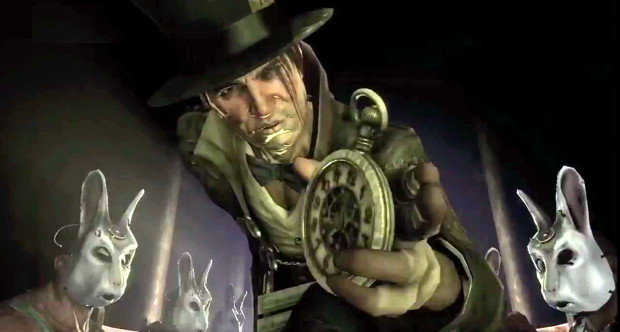
was, though his background plays a key role in the plot.
I mentioned above something about twisted reality as well. Fans of the first game will remember fondly the Scarecrow scenes when things started getting strange and before you knew it you were drugged and having a psychotic episode. For reasons I will not spoil for people now itching to play Arkham Asylum before playing City, let’s just say that I did not expect the same in this game. However, I was wrong as there is a point in the game where you can fall into a trap set by another nut job who sends you into a similar delusional state. This time it is the Mad Hatter who drugs Batman and captures him before fitting him for a bunny hat that should control his mind and you have to button mash to fight it before being subjected to an endless wave of bunny henchmen in a twisted dream-scape world to wrestle free of the control. Overall it does look pretty cool and slightly disturbing to see the twisted Batman stuck halfway between Batman and Bugs Bunny on an acid trip. However the overall feeling was that they felt the need to tack something like this on because of the acclaim it won them in the first game and it all feels a little half-hearted to be honest. The scenes with the Scarecrow in Arkham Asylum were genuinely disturbing to watch while the one scene with the Mad Hatter was not as much.
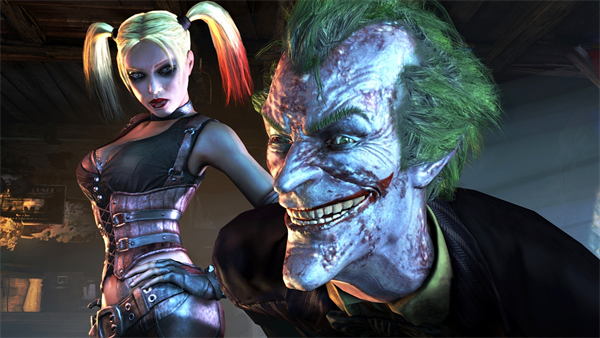
On the whole, the story itself left me feeling a little deflated near the end, and through the game it seems you are always ‘off the prescribed plot’. Essentially, after the aforementioned arrest of Bruce Wayne, Hugo Strange has a little alone time first telling him that he knows he is Batman and that he will not stop him anyway so enjoy your stay blah blah blah. There is also mention of some master plan called Protocol 10 which you have no idea what it is. Turns out that Batman meant to get into Arkham City at some point anyway, and investigate Strange to see if he is up to no good. However, The Joker, still sick from his Titan formula and now dying in Arkham City, infects Batman after setting a trap for him and then the rest of the game is you running around doing errands to find a cure for him, and ostensibly yourself as well. All the while, as you reach trigger points in the main plot, the ubiquitous voice of Hugo Strange counts down to his master plan over the radio telling you how many hours before Protocol 10 is put into place. And at no time do you even do anything that comes close to finding out what Strange is planning anyway until very close to the deadline when you essentially stumble onto something and, some convoluted process of elimination ensues before the penny drops.
However the game does deliver a nice twist near the end, (note I said ‘near’ and not ‘at’), where the real mastermind is revealed. And then suddenly there is a rerun of the end of Arkham Asylum with yet another showdown with The Joker. Just because, y’know. It seemed a little tacked on at the end and honestly it was not needed in my opinion.
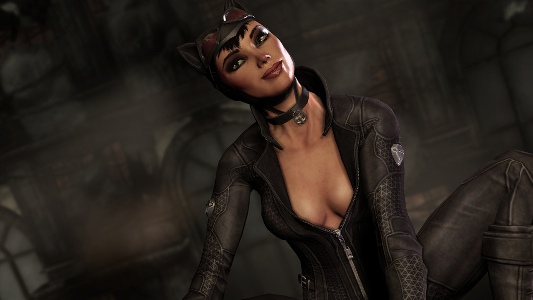
One nice feature is the addition of Catwoman, and a mini-story for her. Or, for PS3 player, the new Robin. At certain points of the game you play as Catwoman going about her own business in Arkham City and she has her own set of weapons and abilities. She has a different detective vision called Thief Vision where she sees different objects but cannot differentiate between an armed and unarmed enemy like Batman. She cannot glide but she can jump very far and use her whip to latch onto a building before climbing up the wall in leaps. You can also latch onto the underside of certain surfaces and crawl along the roof. I don’t know what Robin’s quests are but at one point on the Xbox, he makes an appearance to deliver the line launcher to Batman. While everything else is fired into the city on a rocket… so guess he needed to stretch his legs.
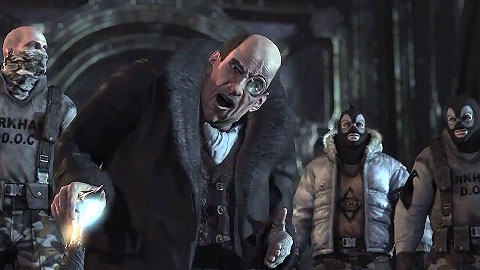
On the subject of other NPCs, the bad guys are nicely revamped, as you can see from Catwoman’s look above, and fighting them presents a different set of challenges for each one. I especially liked the scenes with Mr Freeze where each time you find a weakness to knock him down he adapts his suit and comes back for more. And it took me a few moments to realise but when you look closely at The Penguin you realise his monocle is the bottom of a bottle that seems to have been shoved into his eye, and if you unlock some of the back story by finding Riddler Trophies or solving the verbal riddles by finding the landmarks and scanning them, you get a nice little back story on The Penguin and the bottle in his face.
The ride is still fun, though, and overall the game is very much worth buying. Even if, like me, you are not a comic book buff.